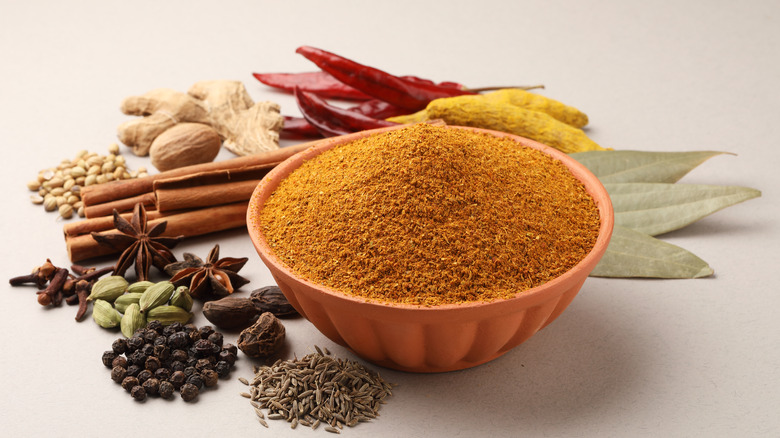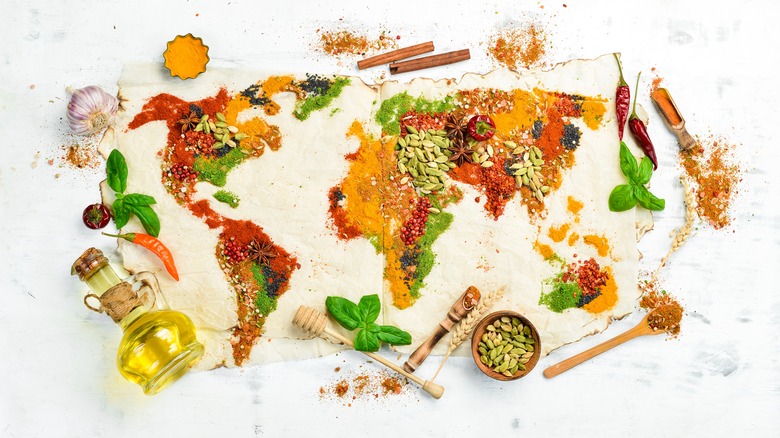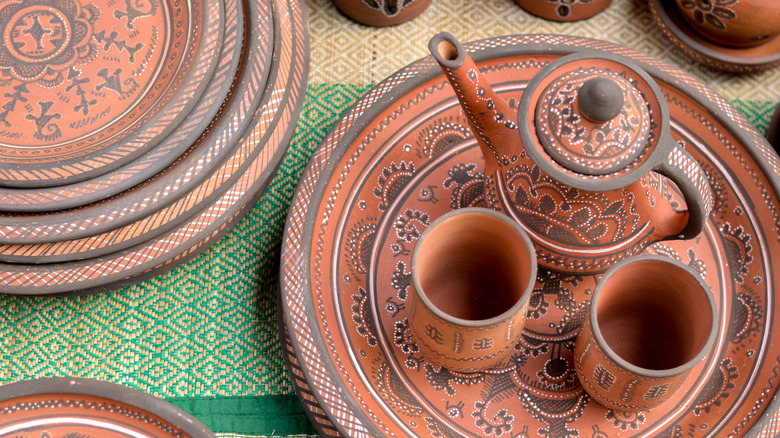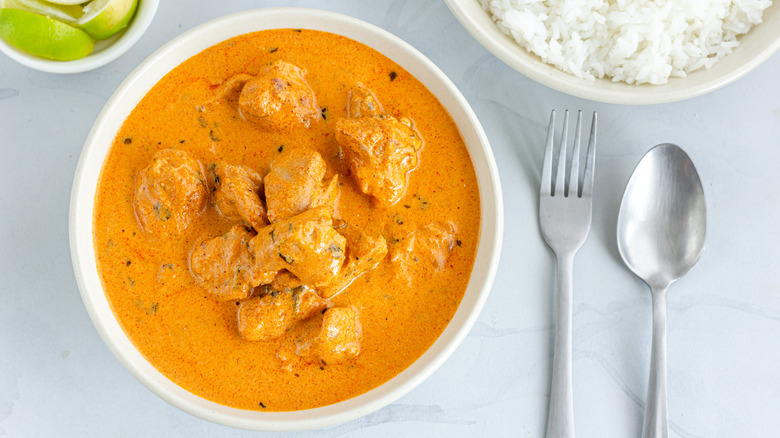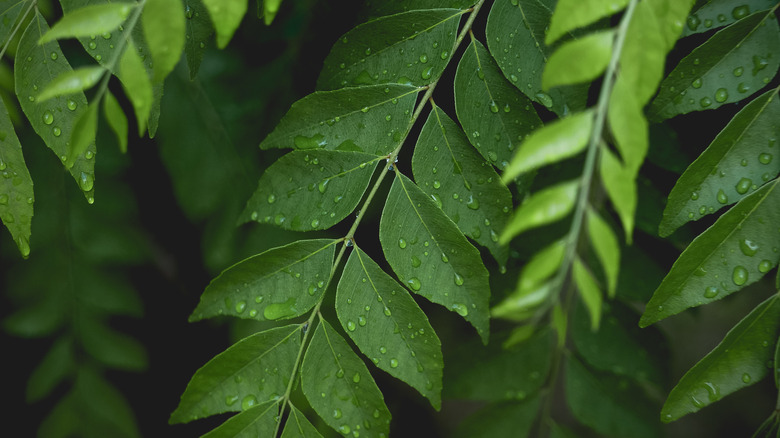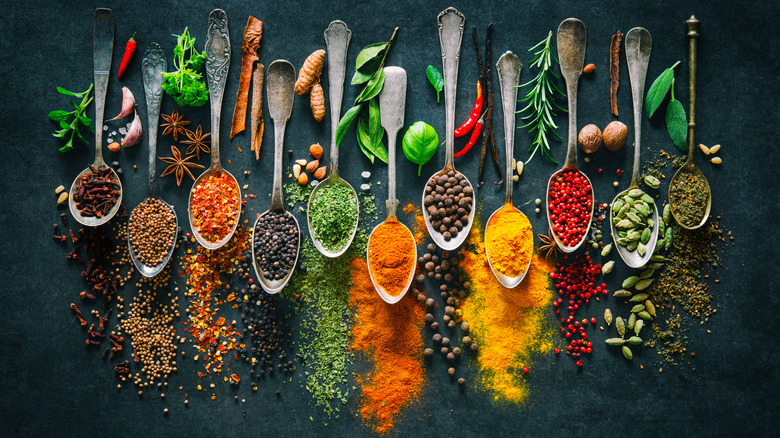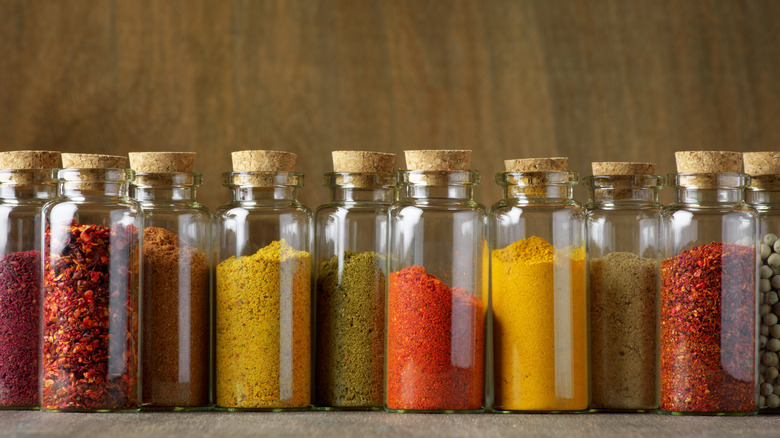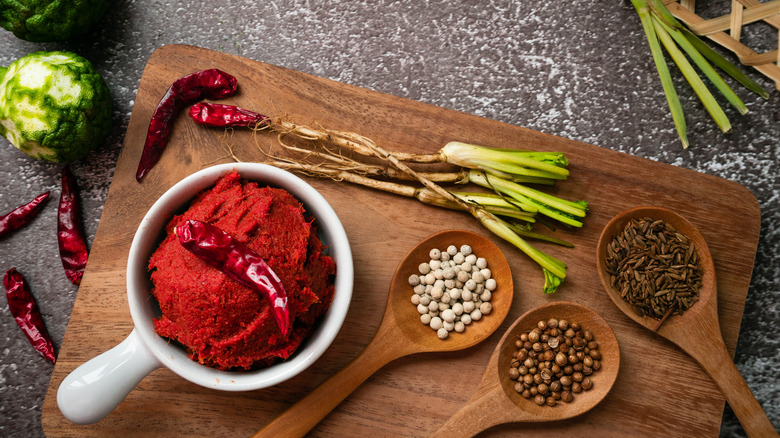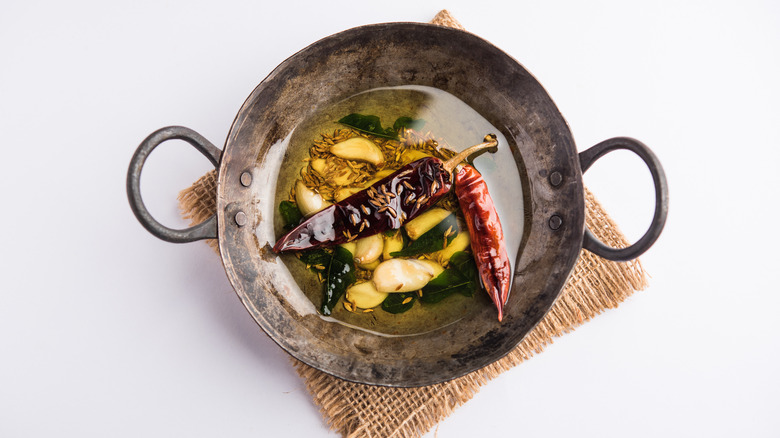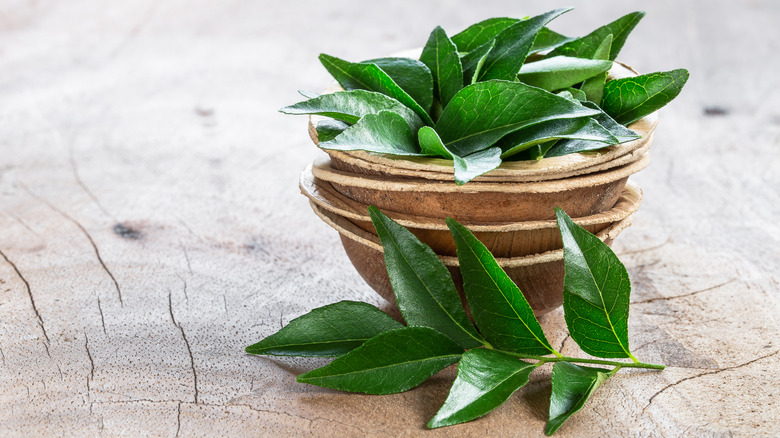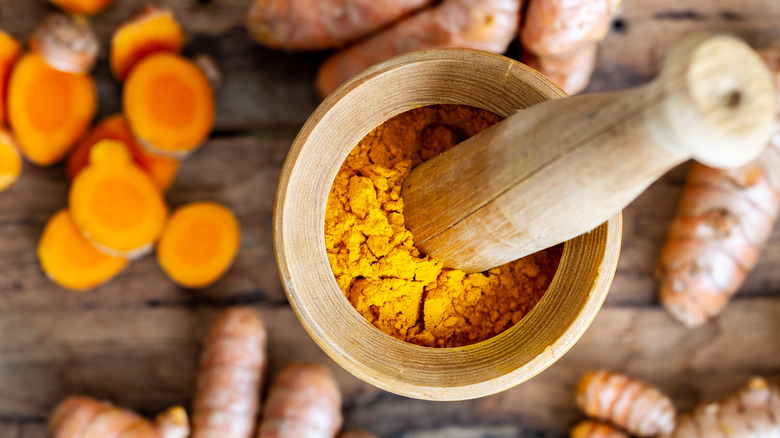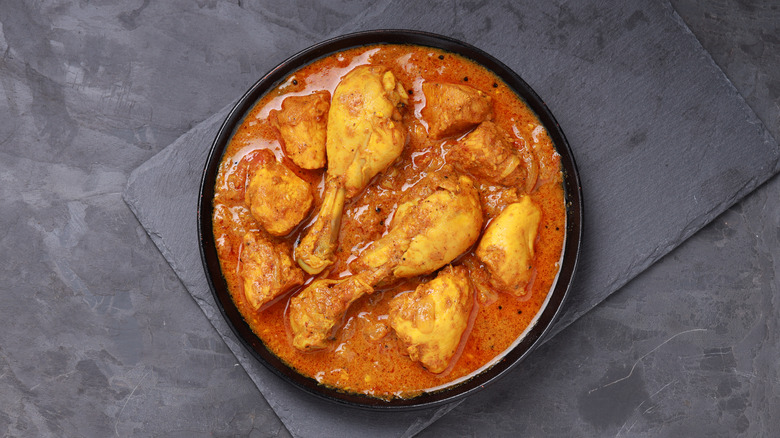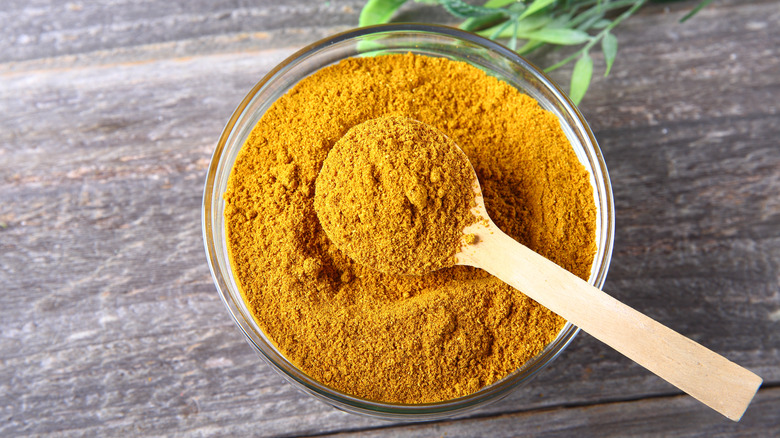What Exactly Is Curry & The Best Ways To Cook With It
You might think of curry as a dish you order from an Indian restaurant or a spice you buy at the grocery store. In reality, the word has many meanings. According to Sameer Kuthe, Chef de Cuisine at Baar Baar in New York, the word was actually invented by the British to describe a variety of dishes. "The actual word is 'Kari,'" he explains, "Which just means sauce or liquid, or any meat, fish, or vegetable preparation with a sauce/liquid and spices. The combinations to make one is varied across the country."
In addition to the wide range of dishes that are referred to as curry, the word can also mean different blends of spices that are used to make the sauce, as well as a paste used most frequently in Thai cuisine and the curry leaf tree that is native to India and Sri Lanka. While the word is often misunderstood because of its multiple meanings, it shouldn't prevent you from attempting to incorporate all the many uses of curry into your cooking. Keep reading to uncover the meaning of curry and how to cook with it.
The dish is part of a range of national cuisines, including Indian, Thai, Japanese, and Jamaican
Although curry dishes are frequently associated with India, many countries have their own variations that hold a significant place in their national cuisines. From Japan's katsu curry inspired by British sailors in the late 19th century to Jamaica's curried goat featuring Scotch bonnet peppers, curry has a global footprint. Though its reach can often be attributed to colonialism and slavery, it was also adopted by many countries due to trade routes that made new spices available.
One of the regions where curry is most prominent is Southeast Asia. Massaman curry and Thai green curry are ubiquitous dishes in Thai cuisine, offering a completely different flavor profile to curries associated with India. According to Vanda Asapahu, owner and head chef of Ayara Thai, Thai curry differs from Indian curry in several key ways. "While not all Thai curries contain coconut milk," she explained to Mashed, "It is often used to thicken central and southern curries. Indian curries tend to be thickened with yogurt or cream." The spices are also prepared differently. "Thai curries start with a curry paste of fresh herbs and spices," she continued, "While Indian curries often begin with an onion-and-tomato base. Thai curry is also typically seasoned with fish sauce, and I believe Indian curry mainly uses salt." These key differences illustrate the range of dishes that fall under the umbrella of curry and the importance of these recipes around the world.
Indians have been eating curry for over 4,000 years
Although British traders invented the word in the 17th century as an umbrella term for all the savory dishes they encountered in Southeast Asia, cooks in India have been making curry for approximately 4,500 years. Due to someone from around 2,500 B.C. choosing not to wash their dishes, scientists have been able to identify several key ingredients left on ancient crockery, namely garlic, turmeric, and ginger, the foundation of modern Indian curries.
The society that is likely responsible for this familiar flavor combination is the Indus Valley Civilization, which was at its height between 2,500 B.C. and 1,800 B.C., covering territory from eastern Iran to New Delhi. These people were known for their state-of-the-art urban design, thriving crafts industries such as pottery and metallurgy, and innovations in agricultural engineering, but despite their sophistication and inventiveness, it's hard to believe that the three ingredients that they were cooking with could still be the gold standard for cooks around the world. It probably wasn't called "curry" back in 2,500 B.C., but ask any Indian cook how they flavor their curries, and those three ingredients will likely feature in their answer.
British and Indian curries vary significantly
Although the British tried to mimic Indian curry, the results morphed over time into something different. Indian curries often use tomatoes as a base, while in the U.K., the sauces tend to be thicker, sweeter, and less spicy. British curry restaurants often offer a patchwork of adulterated regional dishes from all over the Indian subcontinent. Wander into an Indian restaurant in London and the menu is likely to include Southern Indian korma, Kashmiri rogan josh, Pakistani balti, and naan, a flatbread that is from Iran and a handful of Northern Indian regions.
One of the most popular dishes in the U.K. that you might find at an Indian restaurant is actually a product of Scotland. Sometime in the 1970s, a Glaswegian chef decided to serve chicken in a fragrant sauce of canned tomato soup and yogurt, and chicken tikka masala was born. Though it has many similarities to New Delhi's butter chicken, chicken tikka masala is less creamy and a little spicier than its Indian counterpart. The UK is so proud of its invention that Scotland proposed that the European Union give the dish a Protected Designation of Origin in 2009. After trying to consolidate the vast cuisine of the Indian subcontinent into a handful of spice blends and dishes, the British have created their own spinoff cuisine that remains important to their own national culinary identity.
The curry leaf plant is unrelated to curry powder
It is reasonable to assume that the curry leaf is what gives curry dishes their distinctive taste, but this is not the case. Curry leaves, called kariveppilai in Tamil, are a staple of South Indian cooking. Although they resemble bay leaves in appearance, they pack a much more powerful punch to your taste buds. Part citrus, part anise, and part pepper, the intricacy of their flavor is hard to describe and impossible to substitute with anything else.
Besides their distinctive taste, curry leaves are known for their wide-ranging health benefits. Rich in antioxidants, they may reduce oxidative stress in the body, lower the risk of heart disease, and possibly limit the factors that lead to Alzheimer's disease. All of these characteristics make curry leaves a revered medicinal herb throughout Southeast Asia and in alternative medicine throughout the world.
They are not, however, closely linked to curry dishes or curry spice blends. While they are often used as garnishes or blended up to make a paste in some recipes, they are not on the standard list of ingredients in curry powder and they are not readily available throughout many parts of the world that make different types of curry.
There are many different curry powder blends
Curry powder, like the word curry, was an attempt by the British to distill Indian cuisine into something they could understand and recreate. As part of the British colonization of India, hundreds of thousands of Brits moved to the country and fell in love with its food. They began mixing spices to mimic their favorite dishes and brought their concoctions back to England, significantly elevating standard British fare. The first-known published recipe for curry was produced by English author Hannah Glasse in 1747, but it only called for a mixture of pepper, coriander, and rice. Four years later, she included ginger and turmeric, marking the beginning of a new branch of curry in global cuisines.
Kuthe explains that these days, curry powder "is a generic term for spice mix that is used in every household." Turmeric is usually the main ingredient, but common additions include ginger, cumin, mustard seeds, black pepper, fennel seeds, garlic, cayenne pepper, and cinnamon. One of the most popular blends is garam masala, a warm mixture of cardamom, cinnamon, coriander, nutmeg, cumin, and black pepper. But even recipes for garam masala vary. Some include mace and bay leaves, while others stick to fewer ingredients. Other popular curry powder blends include tandoori masala, madras curry powder, and chat masala. One ingredient you are unlikely to see in any curry powder is curry leaves. Despite the name, curry leaves are usually used fresh and put into a sauce whole rather than being an ingredient in a powdered spice blend.
Make sure you know which curry powder your recipe calls for
If your recipe merely calls for curry powder, you'll need to evaluate the dish a little more closely to decide what kind of blend to use. In Indian cooking alone, there are an infinite number of spice mixtures that are used in curries. "Every region, every house has its own unique blend," Kuthe says, adding that even more variation can be found in the ratio of the spices and whether they are roasted. At Baar Baar, the kitchen has specific blends for each dish.
While home cooks who don't make curry on a regular basis may not be prepared to concoct a unique spice blend, they should be aware of what type of dish they are making and which curry powder is most suited to it. Whether you're looking for the warmth of garam masala or the subtle sweetness of madras curry, the spice mix you choose will have a transformative effect on your meal and should be one of the most important factors in your choice of recipe.
Curry paste is not interchangeable with curry powder
While Indian dishes often call for a blend of dried spices, Thai curry dishes usually start with a paste. Both are the basis of curries, but they are vastly different and cannot be used interchangeably. Curry powders are a blend of turmeric and other dried spices including ginger, cumin, cinnamon, fenugreek, cardamom, and many others, depending on the dish.
Curry paste, in contrast, is centered around galangal, a fresh root that is similar to ginger. It is mashed with chili peppers and other fresh ingredients such as lemongrass, ginger, turmeric, and vinegar to create a thick, wet mixture. Unlike curry powders, which range in color from earthy brown to bright yellow, curry paste can be deep red or lime green depending on the dish, with flavors that are just as varied as their colors. With such different ingredients, colors, and textures, curry pastes can hardly be substituted for each other let alone for curry powder. If you want to be creative with your curry recipe, it's best to play around with the veggies and protein that you're planning to douse in the sauce rather than with the ingredients of the sauce itself.
If you're cooking with curry powder, you should be heating it with oil to make tarka
One of the secrets to a good curry dish is to heat the spices in oil first. Most recipes will call for this step, but home cooks might skip it to save time and miss out on its benefits. In India, there are many names to describe this method, including oggarane, chaunk, tadka, and tarka. Regardless of the terminology, the process is the same: heat the spices in oil (usually ghee if you're following an Indian recipe), just enough to release their flavor and aroma. The fat from the oil extrracts and enhances the flavor, ensuring that you're making the most out of your ingredients.
Asapahu suggests a similar process when cooking with curry paste. "Thai curry paste needs to bloom in the sauce pan," she explains. "This requires frying the paste in coconut cream until it 'cracks'— [the] oil separates out, forcing water to evaporate, and making a more concentrated rich curry. This is a critical best practice where you can absolutely taste the difference."
Cooking with curry leaves
Many curry recipes do not include curry leaves, but, as Kuthe told Mashed, there are plenty of ways to use the aromatic plant. "We use it in tempering," he explained, adding that it "can be fried for garnishes, or ground into a paste for curries and/or chutneys." The fresh, citrusy flavor is usually used as an enhancement for other ingredients rather than as the focal point of the dish, making it a versatile ingredient that can be incorporated into a wide range of recipes. Tempering the leaves in oil has the same effect as it does on the curry spices, infusing the fat with flavor before the rest of the ingredients are added.
Aside from heating them in oil and using them as a garnish, curry leaves can be dried and added to soups and curries like bay leaves. You can even crumble and sprinkle them over a dish as a unique type of seasoning. Fresh curry leaves can also be chopped like any other fresh herb and added to dishes like salads and stir-fries for a crisp, citrusy flavor, just as you might add cilantro or basil leaves. They may not be a key ingredient for curry dishes, but curry leaves can put a zesty spin on many different recipes.
Making your own curry powder
Given the variability of curry powders and pastes, you might be wondering if it's best to make your own instead of buying them premade. Curry powder is relatively easy to make at home and can be adapted to suit your tastes. Always start with a base of turmeric and mix in whichever other spices fit your recipe. An easy option is to start with turmeric powder and add three or four other ground spices such as cumin, coriander, cayenne pepper, and ginger. As Kuthe revealed, many households have their own unique curry powder blends with their own ratio of spices. You can buy a tried-and-tested combination from the store in the form of garam masala, tandoori, chaat masala, and many others, or you can develop your own based on your preferences and the type of curry dish you're cooking.
Curry paste is a different story. "The luxury of time is needed to make curry paste from scratch," Asapahu says. "We are not always given that." While she says that many store-bought pastes are good quality, there are certain things to look for and avoid. "For instance," she reveals, "Your green curry should never be shamrock green. When in doubt and to always have a premium at-home experience, buy smaller locally made curry paste."
Making a basic Indian curry
If you've never made a curry before and aren't sure where to start, a basic chicken curry is a good option. With only a handful of ingredients and your choice of curry powder, you'll have a delicious, aromatic meal on the table before you know it. Using a combination of drumsticks, curry spices, coconut milk, and chicken broth, it's an uncomplicated, no-frills dish that will get you hooked on making curries.
The important thing to remember, as Kuthe explains, is to balance the flavors. Even though each curry recipe that he makes as a restaurant chef has its own spice mixture, he reveals that he and his colleagues "try and keep it balanced with the main ingredient so that the spice blend enhances its flavors." Regardless of which dish you are cooking or how complicated the recipe is, always err on the side of balancing the flavors rather than letting one ingredient overpower the others.
Creative uses for curry
If you find yourself with leftover curry powder or paste but don't have plans to make a curry any time soon, there are plenty of other ways you can incorporate the ingredient into your everyday meals. Curry powder can be sprinkled over just about any savory dish for a spicy kick of flavor, whether it's your favorite hummus, a sandwich, soup, or scrambled eggs. You can mix it into chicken or tuna salad, use it in a homemade marinade for roasted meat or vegetables, or make it a standout feature of your salad dressing. Even if you don't have any intentions of making a curry dish, a curry spice blend is a versatile and easy way to upgrade your cooking.
Curry paste can also be used in various ways outside of curry dishes. From adding it to a sandwich as a flavor-packed alternative to your favorite condiments or mixing it into rice for an unexpectedly delicious stir-fry, it can pack a punch in a wide range of dishes that you might not typically associate it with.
